Tajaran Minor Religions: различия между версиями
>Coalf (→The True Cult: Portraits for raskara) |
>Alberyk |
||
| Строка 104: | Строка 104: | ||
*'''Tajani:''' roughly translated to "Short People", the Tajani are described as tiny, elderly Tajara. Usually dressed casually, smoking a pipe, they serve most often as guardians of nature and homes. In common folklore, they're depicted as good-willed but wary of tall folk who have wronged nature so many times. If they catch someone not showing proper respect, they cast spells of forgetting on them to get them lost in the forests. Tajara children have fun building Tajani snowmen or small huts for them to live in. Hand-carved Tajani charms are said to bring good luck and so many adopt them into their trinket repertoire. | *'''Tajani:''' roughly translated to "Short People", the Tajani are described as tiny, elderly Tajara. Usually dressed casually, smoking a pipe, they serve most often as guardians of nature and homes. In common folklore, they're depicted as good-willed but wary of tall folk who have wronged nature so many times. If they catch someone not showing proper respect, they cast spells of forgetting on them to get them lost in the forests. Tajara children have fun building Tajani snowmen or small huts for them to live in. Hand-carved Tajani charms are said to bring good luck and so many adopt them into their trinket repertoire. | ||
*'''Ratajani:''' short, ugly, stump-tailed, and often of varying neon colors the Ratajani, roughly translated to | *'''Ratajani:''' short, ugly, stump-tailed, and often of varying neon colors, the Ratajani, roughly translated to "Bad Short People", are an evil twist on the Tajani folklore. Their nature or purpose is not exactly defined, they're usually titled as ugly, greedy, and the reason for why small bad and unlucky things happen. Faulted for spoiling milk, letting out livestock, making you bump your toes, and sudden emergence for bad smells, the Ratajani seem like an ultimate scapegoat. Misbehaving children are usually compared to Ratajani, but recently with the influence of foreign races, Tajara have come to use it as a slur to describe Skrell. | ||
*'''Pan-Ahran:''' ''“You are one, Three and Two, He is Here, Five and Four, Here He Comes, Seven and Six, You are Gone, None, Pan-Ahran!"''. This well-known nursery rhyme, prevalent mainly on the continent of Das'nrra, had been sung by children since the early Njarir period. Its meaning is insidiously rooted inside a story that speaks of a Pan-Ahran a malicious ghostly figure, which would lurk inside mirrors waiting for an invitation. After being invited, the being would answer three questions for the Tajara’s soul. There has been a heated debate in historical circles about the figure’s origins. One side argues that it’s a metaphor for vanity, while a secondary theory posits that it’s a warning of questioning the Njarir rulers. However, neither side can explain why the figure is always depicted as a shrouded figure standing in a dead field of grass, pointing at the viewer. | *'''Pan-Ahran:''' ''“You are one, Three and Two, He is Here, Five and Four, Here He Comes, Seven and Six, You are Gone, None, Pan-Ahran!"''. This well-known nursery rhyme, prevalent mainly on the continent of Das'nrra, had been sung by children since the early Njarir period. Its meaning is insidiously rooted inside a story that speaks of a Pan-Ahran a malicious ghostly figure, which would lurk inside mirrors waiting for an invitation. After being invited, the being would answer three questions for the Tajara’s soul. There has been a heated debate in historical circles about the figure’s origins. One side argues that it’s a metaphor for vanity, while a secondary theory posits that it’s a warning of questioning the Njarir rulers. However, neither side can explain why the figure is always depicted as a shrouded figure standing in a dead field of grass, pointing at the viewer. | ||
Версия от 19:23, 2 февраля 2022
| Tajaran Lore Pages | ||
|---|---|---|
| Species and Ethnicity Lore Pages | Tajara · Tajaran Ethnicities | |
| Planet and System Pages | Adhomai · S'rand'marr · Hro'zamal · Gakal'zaal · Adhomian North Pole | |
| Culture Society and History Pages | Tajaran History · Notable Tajara · Ma'ta'ke Gods · S'rendarr and Messa · Tajaran Minor Religions · Tajaran Emigration | |
| Governments and Organizations Pages | People's Republic of Adhomai · Democratic People's Republic of Adhomai · New Kingdom of Adhomai · Tajaran Military Structures · Tajara Space Capability · Crevus · Little Adhomai · Free Tajaran Council · Tajaran Educational Institutions | |
| Lore Arcs | Tajaran Cold War Arc · Bad Moon on the Rise Arc · Ghosts of War Arc · Cold Dawn Arc | |
Minor Religions
Raskariim
Raskariim, commonly known as The Cult of Raskara, is a prolific cult on Adhomai. The religion was founded around the same time as the worship of the Twin Suns. While Raskara may seem like a single deity it is in fact split into three aspects, each one leading down a different path and every path subverting something S'rendarr and Messa stand for.
Calling it a cult is in a way a tongue-in-cheek joke for most members; truly the most numerous members of this "cult" are not cultists at all. They are merely rebels, punks, and other subversive elements who wish to go against the mold. The history and background of Raskara provided an excellent way to imprint themselves on the conscience of the Tajara people as something new and something to be afraid of. Clubs and underground metro stations have become the usual hangout for these sorts of people, with the "Lock and Key" club located in Crevus being the most popular. However, unbeknownst to these rebellious youths, there may be a true evil lurking beneath the cover of an anti-establishment movement.
The cults are not against the law per se but the practices and lives these cultists lead usually result in their arrest on other charges. The rural countryside is much harder to police, and those caught usually receive mob justice, be it rebellious youth or genuine cultists. The Parivara titles the Raskariim as heretics of the highest degree and warns that they should be cleansed, re-educated, or eliminated as soon as possible. The recent changes in government and public opinion on working camps have greatly impeded this effort and resulted in a larger amount of Tajara affiliating with this group. The public was becoming more tolerable towards the Raskariim as they were becoming more of an anti-establishment group, however, with the recent events transpiring in Tau Ceti, these efforts were impeded. Many of the more “moderate” members stopped associating with the cult altogether instead of making their own, smaller, less extreme groups.
There are currently 5230 registered members on Adhomai but the number of unregistered cultists might number in the tens of thousands. The famous Vargir Stenovich, the lead singer of the band “Skaam’chirr” (Bloodstorm), identifies himself as a Raskara cultist, a claim which has recently been one of the many reasons why his band has been expelled by all governments of Adhomai, he currently resides in Tau Ceti.
The True Cult
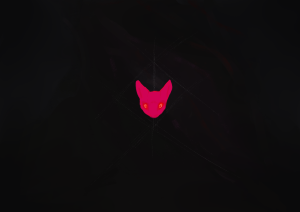
ATTENTION! While playing a Raskariim, even a real Raskariim, is fine. This does not give you an excuse to self-antag. You still need to follow the rules.
While most Tajara see Raskariim as rowdy teens, washed-up alcoholics, or societal losers with an axe to grind, the truth is much more sinister. Behind the general population that calls themselves the Raskariim, there hides a very real cult that worships the moon’s presence. While believing in magic and rituals is nothing out of the ordinary on Adhomai, the Raskariim rituals often involve other illegal activities, such as murder, drug trafficking, or homosexual fast dancing.
While the top officials are aware of this cult, the general consensus is that outside of the occasional kidnapping or murder, they are a minimal threat and that alerting the public would cause more damage than good, to the fractured Adhomai communities. While one would think the events in Tau Ceti would have sparked a mass wave of arrests, the opposite is true. As it would seem, the Adhomai governments are quite fine with the Raskariim operating on foreign soil. Thus, the only pursuers the Raskariim face as the Kin of S’rrendar, who, for their very loud ways, face hindrance from governments every step of the way.
While there is no official hierarchy in the Raskariim safe for the god Raskara, which is most likely a symbolic role, the cult is split into three groups. These groups seem to be fluid, sometimes members move from one group to another, sometimes they infight, sometimes they cooperate, and other times they operate independently. While a considerable amount of funds has been invested into intelligence gathering, scarce little is known about these groups, or how they operate.
Door and Key
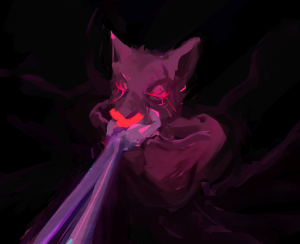
“Officer she had not meant it, they must understand, one works and works the husband comes home late and tired, the kids they scream all day, well how is a poor Tajara housewife supposed to unwind?” – confession of Inika Zizer, convicted of adultery in the summer of 2444.
Drinking, eating, drug-taking, and zero restraint in regards to anything and everything, its the most tempting aspect as it eats away at one's decency and undermines the basics of morality. The Door and Key aspect is the most numerous one in regards to members, but this is due to the fact that many members don’t actually know they are part of it. Their rituals take the form of wild dances, copious drinking, and long drug-fueled trips. The fall into the hands of this cult is gradual, and then sudden. Many unaware members end up as chewed-up husks, barely aware, living from event to event. One bottle leads to a keg, a simple cigarette leads to Venusian ecstasy, and one dance leads to a blood ritual. Eventually, these people end up pulling others into this whirl, wanting to share this feeling with others and inadvertently dooming them to eventual deadly burnout.
The few members that seem fully aware of the goings-on usually pass off as sellers, club associates, VIPs, band-members, and other socialite figures, never fully taking charge or ownership but taking full charge of the tempo, dance, drinks, food, and other things. Yet these dens tend to be the shortest-lived, as these clubs are easy to find and thus easy to shut down, usually for other illegal activities. Yet, these members always seem to slink away at the correct time, fading away like mist, as if their physical forms were not fully there. Like parasites, they jump from club to club, moving on once they’ve had their fill. The only exception is the club called The Lock in the city of Crevus, which seems to reappear no matter how many times it is shut down.
King of Maggots
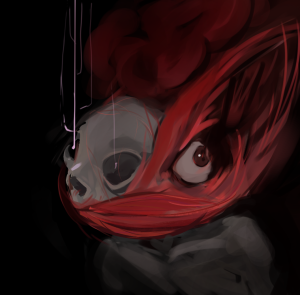
“…so he delivered the package and the next day he woke up with his debt gone. Of course, after that, I had to deposit 200 credits into a different account but thanks to that his wife got her medicine which the doctors said she couldn’t get! But he had to change jobs for his own job to be worked by someone else and then move houses so another could solve the issue with the car and then he, he realized he was living the life of someone else.” - confession of Iliy Al-Tahara, convicted of driving a car without a license in the summer of 2460.
Precious little information is known about this aspect, and outside of their general pattern, much remains a mystery. Similar to the previous aspect, most members seem to be unaware of their membership, or, at least, not aware of how deep their membership goes. But in a sense, it is this cult that requires the most participation from its members. The story is always the same, a Tajara does a small favor for a group that promises to help him out of his issues, something like delivering a package. Once that package is delivered, the person is indeed cured of their ailments, be it work, health, or family, it seems nothing is beyond fixing to this group. However, the Tajara then finds that the package was transporting a bomb and he is now in deep trouble, the blackmail begins and the Tajara is sent on worse and worse errands, each of which carries a reward or a threat. Yet this charade never lasts forever and this pyramid scheme tends to collapse onto those participating. Frequently, the investigators find out that while the errand runners would never meet each other, they would frequently be the ones running those errands for each other, creating a strange cycle of assistance and sabotage.
For the organizers, this means continued freedom and no real trail leading back to them. Like maggots after they’re done feasting, they transform into flies and flee the scene. The little intel available usually reveals that members tend to masquerade as loan sharks, bankers, members of the clergy, and even government officials, in general, those one would expect to come to for help. Strangely enough, from time to time Tajara that have been photographed or identified as members are arrested. Yet upon arrest, they’re usually unaware of anything happening and oftentimes have a very strong alibi. Rumors have started circulating about “face stealing”, but the truth is they’re most likely using masks and identity theft to disguise themselves.
The Black Mirror
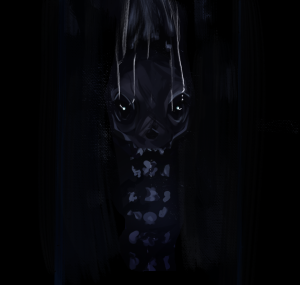
They aren’t going to get much from him, he went upstairs as always, he knocks, the Rafamabrain owes him rent for the last three months, he busts in, nobody inside, empty, just weird writing all over the walls.” – confession of Mirin Il-Basil, detained for questioning during an investigation into electronic theft 2443.
While the previous cults have precious little about them, the cult of The Black Mirror is truly enigmatic. Unlike other groups, there doesn’t seem to be a common identifier and the authorities struggle to link members to each other. The most common sign of their activity is when one or more Tajara go missing in the neighborhood, their residences usually filled with occult books, charms, and scrawlings on the walls. The only link known is a reputed “Black Glassed Mirror”, which is a ritual frequently circulated on online message boards as a “Spookybread”. Alongside frequent mentions of a “Mirror through which The Stranger gazes and speaks”, it is most likely that this cult has a significant online presence. Authorities have concluded that the likeliest suspects are hackers, with the “Black Mirror” being a metaphor for computer screens.
Thus the main group’s authorities are instructed to look out for are techies. Hackers, researchers, librarians, and in general those who have access to computers and a drive for knowledge. Still, the question remains why black-tinted mirror shards are found in these apartments. Or why these missing members show up from time to time, in reflections or camera feeds. The Chaniska Reports
Suns Penitent
Suns Penitent is a branch of S’rand’marr faith with whom the official faith refuses to associate with. Although they’re identical to the regular followers of the S’rand’marr faith, they pride themselves in their pacifism, charity and have thousands of members all across Adhomai. While they’re a relatively new sect, having been created in 2434, the Suns Penitent have skyrocketed in membership due to the conflict.
Although their faith is very similar to the mainstream branch, the main differentiation is their belief in the afterlife. As they do not believe there is a cleansing period, but instead that this earth is that cleansing. Thus they expect everyone to live as pious of a life as possible, and accept suffering as part of the process before they are let straight into Messa’s forever. The most populous groups in their midst are orphans, widows, the disabled, and others who have suffered the most in war. They hold abstinence against all forms of addiction as they believe that earthly pleasures bind one to this realm and hinder the process, likewise, all joining members must donate all their belongings to the church.
What makes them truly despicable in the minds of the Tajara and what has marked them as heretical by the Parivara, is their practice of “mercy killing”. Although they are staunch pacifists, they believe that those in a mentally unstable or catatonic state are already gone and that their bodies should be laid to rest along with their minds. Now, as the fighting is dying down, the Suns Penitent are seeing a huge drop in memberships, driving them to more and more extreme recruitment efforts.
Njarir'Akhran Worship
The Njarir'Akhran Worship is considered an extinct religion based on the adoration of the Adhomian monarchs and their lineage as divine beings or avatars of the Tajaran Gods. The faith's origins can be traced back to the Tajaran pre-history when the ruling class was treated as holy. Njarir'Akhran Worship reached its peak during the rule of the Dirrnavirr'Almalik dynasty. Temples and statues were erected all across southern Ras'nrr to celebrate the avatars of the Suns. Sacrifices and games were hosted during holidays to honor the God-kings. The faith's hegemony came to an end with the Migration Period and the ascension of the Church of S'rand'marr, which some claim originated from Njarir worship.
Njarir'Akhran Worship would resurface again during the late Gunpowder age. Taking inspiration from the ancient God-Kings, some ambitious kings claimed to be the manifestations of the Gods. While this caused an uproar among the religious authorities of the time, these claims were deemed to be nothing but another eccentric act of the decadent nobility by the population. Unlike the ancient version, veneration was limited to sumptuous ceremonies proclaiming the monarch’s bloodline to be holy and the construction of large mausoleums to safeguard their bodies for an eventual return. More faithful and reasonable rulers would usually condemn the consecration of their bloodlines upon ascension to the throne. Some dynasties have been sanctified and unsanctified several times throughout the generations. Ultimately, Njarir'Akhran Worship in this period was a sporadic phenomenon linked to the increasing abuses and megalomania of the nobility. The faith slowly declined until it was finally destroyed by the First Revolution. The massacre of most of the nobility proved to all of Adhomai that the Njarir'Akhran were not Gods.
All that remains nowadays of the Njarir'Akhran Worship are ruins, hidden tombs, and surviving religious texts. However, the tradition of associating popular figures - such as Nated, Hotak, and Hro'rammhad - with deities is still alive.
Krizamiraeism
Krizamiraeism is an ancient Tajara religion that originated in the Adhomian Pre-History. Unlike Ma’ta’ke and the church of S'rand'marr, Krizamiraeans did not believe that the Suns were deities. Instead, the sect believed that Adhomai was a prison built in a lower plane by malicious figures that would manifest themselves in the sky as the S’rendarr and Messa. The Tajara were considered to be higher beings, also known as Krizamir, that were captured by the two mischievous false deities and trapped in limited physical bodies. Krizamiraeism preached the material world as purposedly built to torture and mislead its inhabitants. Escaping to elevated planes was the main pursuit of the followers of this faith; something that was only thought possible through a secret magical ritual.
Krizamiraeans would study mystical texts, travel around to speak with other faithful, and lead ascetic lifestyles in search of the fabled ritual. Most of their ceremonies involved large gatherings to discuss their findings and perform sacrifices during the practice of magic. Because of their instance towards the Suns, they were violently persecuted after the rise of the Incarnate. As their number dwindled, the Krizamiraeans would become more recluse and paranoid. The communal assemblies were replaced by recluse Tajara studying in private and refusing to share anything with their peers. Later writings would claim that the Njarir’Akhran were agents of the Suns sent to stop anyone from escaping Adhomai.
After centuries of persecution, Krizamiraeism vanished during the early Gunpowder Age. Its existence is only known through texts preserved in the libraries of Sana Sahira and Olska. Despite their fate, Krizamiraeans' ideas and interest in magic would influence mystics and occultists throughout history.
Myths and Mythological Beings
- Saba Yarra: a mythical old Tajara woman, usually depicted as wrapped in heavy furs and walking on thin stilts the height of trees. She was a popular folkloric figure which marked the shifting of seasons, as at the end of winter a pyre would be assembled in the village, upon which an effigy in her likeness would be burned. She is usually described as a malevolent entity that would capture children who strayed into the woods and steams them in her cooker. A village in the Din'akk Mountains wishes to create an official faith around her, as they claim she is a deity within their forests. This suggestion has been repeatedly denied, much to the dismay of the souvenir sellers.
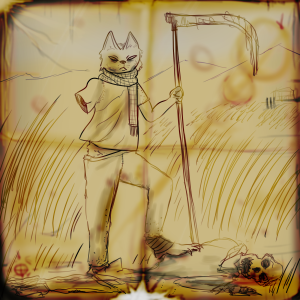
- S'Mara: S'Mara (The Orphan) is a vengeful spirit appearing in Adhomai folklore and stories dating back many centuries. She is always described as a one-handed young girl, with a black-bladed tool of some kind. In all her stories, she appears as a pursuer, hunting down oathbreakers and traitors of all kinds. In recent history, a photo taken by an unknown cameraman with a disfigured girl standing over a decayed corpse has become the staple ‘look’ of The Orphan; the original photo is currently being stored in the Nal'tor Museum of Mystery. Copies of this photo have been repurposed by the propaganda industries on all sides, hoping to scare off would-be deserters and traitors.
- Sham'Rrihay (Wind Demon): Sham’Rrihay is described as a massive bald, dark-red creature the size of ten ships. He is most remembered in a tale recounting the creation of Sana Sahira. According to this legend, Sham’Rrihay was a gigantic wind demon that could blow cities apart with a single flap of his mighty wings. However, one day, a priest of S’rrendar challenged the demon to blow the stars out of the skies if he is so great. The demon tried again and again but failed each time, eventually, frustrated, he flew up towards the stars to snuff them out with his own claws and was never seen again. While this myth clearly outlines the demon’s death, stories of his existence persisted afterward. According to these tales, he returns to Adhomai as a ghastly specter, calling together a massive Sham’tyr host which flies through the skies, eating anyone unlucky enough to wander the frozen forests and plains without a torch.
- Cae'rrin: a shape-changer, this one is described as malicious. These shape-shifting creatures are described as “Furless Tajara” who use all four of their limbs to move about, with bones protruding from their body. They are said to snatch babes from their cribs and replace them with their own. Those children given by the Cae'rrin are described as quiet, intelligent, and well-behaved but also seemingly cold, unfeeling, and un-empathetic. It is said that once such a child reaches the age of 16 it’ll devour both its parents and fly off into the night, to join its real parents. Today we know it is most likely vilification of the Hakh'jar disability.
- Raskaren: ancient Tajara myths describe pale figures reflecting in the moonlight of Raskara, unable to walk in the sun without the cover of shade these beasts drink blood, perform debaucherous acts, and enslave young Tajara maidens to their bidding, they are called "Children of the Moon". This myth has most likely originated from anti-noble sentiments of the time. Nobles having spent most of their time in castles usually had paler, sleeker-looking fur, some theories circulate that it is also a demonization of the M'sai, who used to function as the enforcer class for the Njarir. It continues to be perpetuated today, the Free Tajaran Council, in particular, enjoys using this comparison and the word has been considered illegal in territories of NKA.
- Tajani: roughly translated to "Short People", the Tajani are described as tiny, elderly Tajara. Usually dressed casually, smoking a pipe, they serve most often as guardians of nature and homes. In common folklore, they're depicted as good-willed but wary of tall folk who have wronged nature so many times. If they catch someone not showing proper respect, they cast spells of forgetting on them to get them lost in the forests. Tajara children have fun building Tajani snowmen or small huts for them to live in. Hand-carved Tajani charms are said to bring good luck and so many adopt them into their trinket repertoire.
- Ratajani: short, ugly, stump-tailed, and often of varying neon colors, the Ratajani, roughly translated to "Bad Short People", are an evil twist on the Tajani folklore. Their nature or purpose is not exactly defined, they're usually titled as ugly, greedy, and the reason for why small bad and unlucky things happen. Faulted for spoiling milk, letting out livestock, making you bump your toes, and sudden emergence for bad smells, the Ratajani seem like an ultimate scapegoat. Misbehaving children are usually compared to Ratajani, but recently with the influence of foreign races, Tajara have come to use it as a slur to describe Skrell.
- Pan-Ahran: “You are one, Three and Two, He is Here, Five and Four, Here He Comes, Seven and Six, You are Gone, None, Pan-Ahran!". This well-known nursery rhyme, prevalent mainly on the continent of Das'nrra, had been sung by children since the early Njarir period. Its meaning is insidiously rooted inside a story that speaks of a Pan-Ahran a malicious ghostly figure, which would lurk inside mirrors waiting for an invitation. After being invited, the being would answer three questions for the Tajara’s soul. There has been a heated debate in historical circles about the figure’s origins. One side argues that it’s a metaphor for vanity, while a secondary theory posits that it’s a warning of questioning the Njarir rulers. However, neither side can explain why the figure is always depicted as a shrouded figure standing in a dead field of grass, pointing at the viewer.
- Bolfurrrr: most myths serve to teach a lesson or make an example out of someone, the story of Bolfurrrr exemplifies this. Bolfurrrr is described as a fat round Tajara, with large legs, a big nose, big ears, and small eyes, and two too many R’s in his name. He’s characterized as a jolly, well-meaning figure that causes mischief and trouble through his unfortunate incompetency. Adapted into film, later on, Bolfurrrr has become a household icon and the pinnacle of early Tajara satirical humor. With shorts such as “Bolfurrrr cooks the army”, “Bolfurrrr gets offensive” or “Bulfurrrr tanks the mechanized division”, Bolfurrrr had become an educational figure for the troops. Explaining the various risks and procedures in the army in an entertaining manner.
- Aghar'mahrk: a mythical world that is said to be located in Adhomai’s core. Aghar'mahrk is commonly described as a place of untold wealth and wonders; it is supposedly inhabited by a race of magical Tajara. Legends claim that the entrance is hidden somewhere on the planet’s poles, a rumor that was likely inspired by the large tunnels made by the Hma'trra Zivr wormlings in the ice. Several expeditions were launched in the past by the nobility to find and claim the subterranean realm. Because of the failure of the previous endeavors and its obvious status as a legend, most Tajara consider Aghar'mahrk to be nothing but another myth.
Occultism
Because of rampant superstition and inclination towards oral tradition, the occult always had a long relationship with the Tajara. Since time immemorial, mystics, fortune-tellers, soothsayers, alchemists, and healers have existed in the Tajaran society. These practitioners of the occult had a mixed relationship with the population and the clergy; sometimes they were seen as blessed by the gods to perform miracles and other times they were condemned to death for allegedly having a pact with Raskara. As the church lost most of its temporal power to the Njarir’Akhran monarchies during the Steeple Age, the presence of occultists in the courts steadily increased. Some Kings dared to have their own court magicians or even entire cabals of mystics. Before the first contact, many nobles and Hharar intellectuals were deeply interested in the supernatural. Secret societies and occult organizations were common at that time. The First Revolution forced these individuals back to the edges of society. The secular - sometimes even atheistic - Hadiist ideology saw the interest in the occult as suspicious behavior. The biggest esoteric organization in modern Tajaran history, the Society of the Hidden Dusk, was forced to flee from Adhomai during Malik Hadii’s ascension to power.
The Second Revolution and the Armistice was a ray of hope for those who are interested in occultism. Because of the appeal to tradition and religious renaissance brought by the Al’mariists and Royalist ideologies, mystics and occultists now have a higher degree of freedom to operate. While traditional healers and wisemen still exist in Adhomai, more modern occultists have started to appear. In meetings of their secret societies or extranet forums dedicated to urban legends, these Tajara discuss and explore subjects deemed as pseudosciences. It is common for Raskariim to infiltrate and recruit from these circles. Some esoteric concepts - such as the belief that Supreme Commander Nated is a prophet - have slowly started to trickle into Adhomian politics. Current Tajaran occultism draws inspiration from ancient myths, the Ma’ta’ke Gods, Krizamiraeism, and even Raskara’s aspects.
Ancient Tajara Theory
The Ancient Tajara Theory is an esoteric belief proposing that the pre-historic Tajara were spiritually and technologically more advanced than their modern counterparts. The theory originates from pre-contact occultist societies. Misinterpreting archeological findings that suggest that the Tajara species once inhabited caves, proponents of this idea claim that the Tajara originated from the mythical underground realm known as Aghar'mahrk. They were created by the very primordial forces that shaped the universe, instead of evolving from primitives.
According to the theory, the Ancient Tajara were once united by a planet sprawling empire with its capital in Adhomai's core. The more deranged theories claim that these Tajara had highly advanced technologies - marvels that would rival or surpass what is known today - and even magical powers. However, due to some unknown disaster, the Tajara on the surface were cut off from Aghar'mahrk; the Ancient Tajara then quickly devolved into multiple ethnicities without contact with its homeland. Because of this supernatural origin, the Tajara are considered to be a people of immense untapped potential; the chosen species that will soon conquer its rightful role in the galaxy when the right conditions are met. Conspiracy theories propose that the galactic powers are fully aware of the Ancient Tajara origins and are actively sabotaging the Tajara people to stop them from reclaiming their lost might.
Despite its origins, the Ancient Tajara Theory survived the First Revolution; it was later adopted by modern occultists, conspiracy theorists, and Tajaran supremacists. The extranet has become a fertile ground to disseminate these ideas and unite its followers. While still considered a fringe belief by the great majority of the Tajara, the theory has found its supporters among the most radical Adhomian elements. Some Vanguard Natediists have adopted these ideals to legitimize their rabid xenophobia. Revival Royalists incorporated the theory as well to justify the nobility's right to unquestionable rule; they added the narrative that the Njarir'Akhran are the closest race to the Ancient Tajara.
Symbols
In a similar manner to the other species, symbols have an important role in Tajara society. Prior to First Contact, much of the symbolism present in works of art had its roots in religion and esotericism. After the Revolution, propaganda and political symbols took the centerpiece. However, amulets and icons are still present in nearly every Tajara home.

Notable Symbols
- Twin Suns Icon: an ancient icon representing Adhomai's suns. While the Church of S'rand'marr claims it was originally a religious symbol, archeological evidence traces its origins to the Tajaran pre-history. The Twin Suns Icon represents auspiciousness, protection, and perseverance. It is commonly found on clothing, weapons, vehicles, and carved on the entrance of homes. When used on flags, it is considered to be a symbol of incontestable rulership.

- Ancient Tajara Herald: an occultist symbol created by the Society of the Hidden Dusk to portray their esoteric ideals. To give its creation more legitimacy, the Society claimed it was found in ancient relics. The sphere represents Adhomai; its hollow upper section is the surface while the inferior one is Aghar'mahrk. The icon was later adopted by the Njarir'Akhran Renewal Fraternity. The Fraternity added a square to portray the four Tajaran ethnicities and a red drop representing the Njarir'Akhran's supposed link to the Ancient Tajara.

- Raskara Sigil: a symbol used by Raskariim to evoke Raskara's attention during rituals. Due to its affiliation to no particular aspect of Raskara, the icon became widely known outside of the cult. Older Tajara consider the sigil to be highly offensive. In more modern, secular depictions, the Raskara Sigil is a stand-in for evil forces. The real meaning behind the red circle remains highly disputable; some claim it represents the blood of followers killed during the repression of the cult throughout the ages.
| Tajaran Lore Pages | ||
|---|---|---|
| Species and Ethnicity Lore Pages | Tajara · Tajaran Ethnicities | |
| Planet and System Pages | Adhomai · S'rand'marr · Hro'zamal · Gakal'zaal · Adhomian North Pole | |
| Culture Society and History Pages | Tajaran History · Notable Tajara · Ma'ta'ke Gods · S'rendarr and Messa · Tajaran Minor Religions · Tajaran Emigration | |
| Governments and Organizations Pages | People's Republic of Adhomai · Democratic People's Republic of Adhomai · New Kingdom of Adhomai · Tajaran Military Structures · Tajara Space Capability · Crevus · Little Adhomai · Free Tajaran Council · Tajaran Educational Institutions | |
| Lore Arcs | Tajaran Cold War Arc · Bad Moon on the Rise Arc · Ghosts of War Arc · Cold Dawn Arc | |







